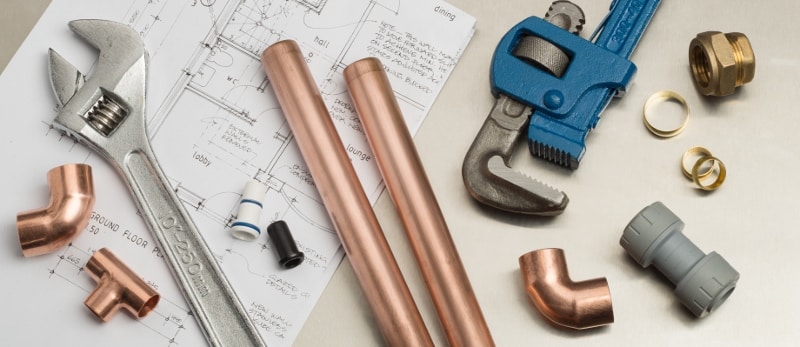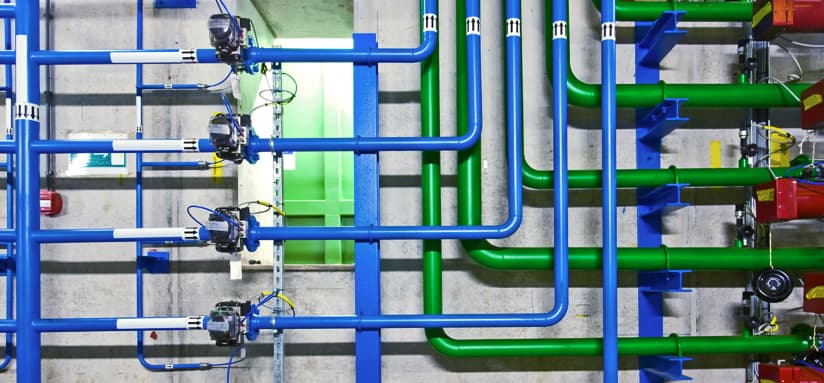The Anatomy of Your House's Plumbing System Explained
The Anatomy of Your House's Plumbing System Explained
Blog Article
We have noticed this great article about The Inner Workings of Your Home's Plumbing listed below on the net and figured it made sense to share it with you over here.

Recognizing how your home's pipes system functions is vital for every single home owner. From delivering tidy water for alcohol consumption, cooking, and showering to securely removing wastewater, a properly maintained plumbing system is vital for your family's wellness and convenience. In this detailed guide, we'll check out the elaborate network that composes your home's plumbing and offer pointers on upkeep, upgrades, and dealing with usual problems.
Intro
Your home's pipes system is more than just a network of pipelines; it's an intricate system that ensures you have accessibility to tidy water and efficient wastewater removal. Understanding its parts and just how they interact can assist you protect against expensive fixings and ensure whatever runs smoothly.
Standard Elements of a Plumbing System
Pipes and Tubing
At the heart of your plumbing system are the pipes and tubing that carry water throughout your home. These can be made of numerous products such as copper, PVC, or PEX, each with its advantages in regards to toughness and cost-effectiveness.
Fixtures: Sinks, Toilets, Showers, and so on.
Fixtures like sinks, commodes, showers, and bath tubs are where water is used in your home. Understanding how these fixtures attach to the pipes system helps in identifying issues and preparing upgrades.
Shutoffs and Shut-off Factors
Shutoffs regulate the circulation of water in your plumbing system. Shut-off shutoffs are essential during emergencies or when you require to make repair work, enabling you to isolate parts of the system without interrupting water flow to the entire house.
Supply Of Water System
Main Water Line
The major water line attaches your home to the local water system or a personal well. It's where water enters your home and is distributed to various components.
Water Meter and Stress Regulatory Authority
The water meter actions your water use, while a pressure regulatory authority makes certain that water streams at a risk-free stress throughout your home's plumbing system, preventing damages to pipes and fixtures.
Cold Water vs. Warm water Lines
Comprehending the distinction between cold water lines, which provide water directly from the main, and warm water lines, which bring heated water from the hot water heater, aids in fixing and planning for upgrades.
Water drainage System
Drain Piping and Traps
Drain pipelines carry wastewater far from sinks, showers, and commodes to the drain or septic tank. Catches avoid sewage system gases from entering your home and likewise trap particles that might create blockages.
Ventilation Pipelines
Ventilation pipelines allow air right into the water drainage system, protecting against suction that might slow drain and cause catches to vacant. Appropriate air flow is essential for keeping the integrity of your plumbing system.
Importance of Proper Water Drainage
Ensuring correct water drainage protects against backups and water damages. On a regular basis cleaning up drains pipes and keeping catches can avoid pricey repair work and prolong the life of your plumbing system.
Water Heater
Types of Water Heaters
Hot water heater can be tankless or conventional tank-style. Tankless heating units heat water on demand, while tanks save warmed water for immediate use.
Upgrading Your Pipes System
Reasons for Upgrading
Updating to water-efficient components or replacing old pipes can enhance water high quality, minimize water costs, and increase the value of your home.
Modern Plumbing Technologies and Their Benefits
Discover modern technologies like wise leakage detectors, water-saving toilets, and energy-efficient water heaters that can save cash and decrease environmental impact.
Price Factors To Consider and ROI
Calculate the ahead of time prices versus long-lasting cost savings when taking into consideration plumbing upgrades. Many upgrades pay for themselves with lowered energy bills and less repairs.
Just How Water Heaters Attach to the Plumbing System
Recognizing how hot water heater connect to both the cold water supply and hot water distribution lines helps in diagnosing problems like inadequate hot water or leaks.
Maintenance Tips for Water Heaters
On a regular basis purging your hot water heater to get rid of debris, examining the temperature level setups, and evaluating for leakages can expand its life-span and boost power performance.
Typical Plumbing Issues
Leaks and Their Causes
Leakages can take place as a result of maturing pipes, loose installations, or high water stress. Resolving leakages without delay protects against water damages and mold growth.
Clogs and Clogs
Obstructions in drains pipes and bathrooms are typically caused by purging non-flushable things or a build-up of grease and hair. Using drain displays and being mindful of what goes down your drains pipes can protect against blockages.
Indicators of Pipes Issues to Expect
Low tide pressure, slow drains pipes, foul odors, or uncommonly high water bills are signs of possible plumbing troubles that must be dealt with promptly.
Pipes Maintenance Tips
Regular Assessments and Checks
Schedule yearly pipes inspections to capture problems early. Look for indicators of leakages, rust, or mineral buildup in taps and showerheads.
DIY Upkeep Tasks
Basic tasks like cleansing faucet aerators, checking for commode leaks making use of color tablet computers, or shielding exposed pipelines in chilly environments can stop major pipes problems.
When to Call a Specialist Plumbing
Know when a plumbing issue calls for specialist experience. Attempting intricate fixings without proper expertise can lead to even more damage and greater fixing expenses.
Tips for Minimizing Water Usage
Basic routines like fixing leakages promptly, taking shorter showers, and running full lots of laundry and meals can conserve water and lower your energy bills.
Eco-Friendly Plumbing Options
Take into consideration lasting plumbing products like bamboo for floor covering, which is durable and environment-friendly, or recycled glass for countertops.
Emergency Preparedness
Steps to Take Throughout a Pipes Emergency situation
Know where your shut-off valves lie and just how to turn off the water in case of a burst pipe or significant leakage.
Significance of Having Emergency Situation Calls Helpful
Keep call info for neighborhood plumbings or emergency situation services easily offered for fast action throughout a plumbing situation.
Ecological Impact and Preservation
Water-Saving Fixtures and Devices
Setting up low-flow taps, showerheads, and toilets can considerably minimize water usage without giving up performance.
DIY Emergency Situation Fixes (When Relevant).
Short-term repairs like making use of duct tape to spot a dripping pipe or positioning a bucket under a dripping faucet can minimize damages till a professional plumbing professional arrives.
Conclusion.
Comprehending the makeup of your home's pipes system encourages you to preserve it properly, saving money and time on fixings. By following routine upkeep regimens and staying notified about modern pipes modern technologies, you can ensure your plumbing system runs successfully for several years to find.
HOW YOUR PLUMBING SYSTEM WORKS
Which Pipes Do What?
Blue lines = fresh water supply entering the building Red lines = hot water supply entering the building Grey lines = pipes carrying waste away from the building and venting pipes carrying gases away from the building (through the roof) YOUR MAIN PLUMBING SYSTEMS
There are two main plumbing systems that support your home s basic plumbing needs one that brings clean water into your home, and one that sends dirty water away from your home. Connected to the toilet, bath, shower, and other faucets in your home, these two systems keep your water flowing in the right directions.
ACCESSING FRESH WATER
Fresh and clean water is brought into your home through the main water supply line . Filtered through one pipe, this water is pressured to flow into the various fixtures in your home at any given time.
This water can be sourced from a well located on your property, a pond or river (mostly cottages), or, as in most cases, from the city s municipal water treatment centre. However, it is important to note that water that is untreated, such as the water siphoned from ponds or rivers, may not be safe to drink. Personal water supplies always need to be treated for hardness and contaminants before consumed.
MUNICIPAL WATER SUPPLIES
Improve taste and odour Remove sediment Eliminate hardness Reduce chlorine COLD WATER SUPPLY VS. HOT WATER SUPPLY
Cold water flows into your home or building through the service line, which then distributes hot or cold water to your fixtures. This line is most commonly run through a central column that runs floor to floor. Hot water runs in short and straight pipes as the longer the pipeline, the more heat that will be lost in the transfer. Having shorter pipes also allows residents to access hot water more quickly.
WASTE WATER SYSTEM
Your wastewater system is divided into two parts pipes that send wastewater away from your home and venting pipes that send sewer gas away from your home. Sewage water travels through pipes that flush the water and waste towards local sewers that are operated and managed by your city or town. Most sewer systems rely on gravity to move the wastewater to where it needs to go.
The further away from your toilet or sink, the larger wastewater pipes become. This allows for waste to be disposed of from various parts of your home or business at once without pipe blockages. The angle and flow of these pipes are also essential for keeping your waste pipes clear of build up.
https://harrisplumbing.ca/how-your-home-plumbing-system-works/

I am very intrigued by Anatomy of a House: Understanding the Components and I hope you liked the post. Appreciated our review? Please share it. Help other people locate it. Kudos for your time. Revisit us soon.
Click Here To Read More Report this page